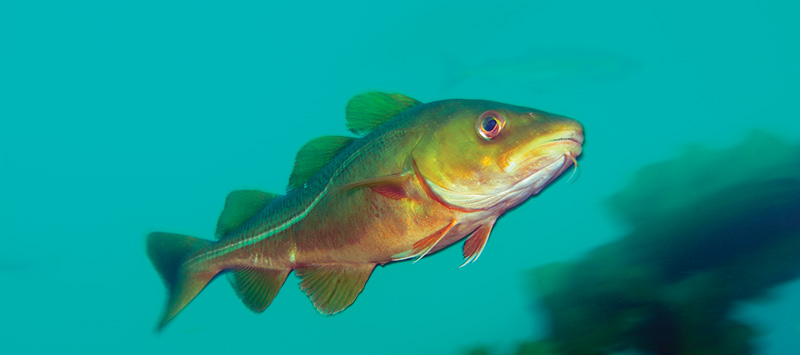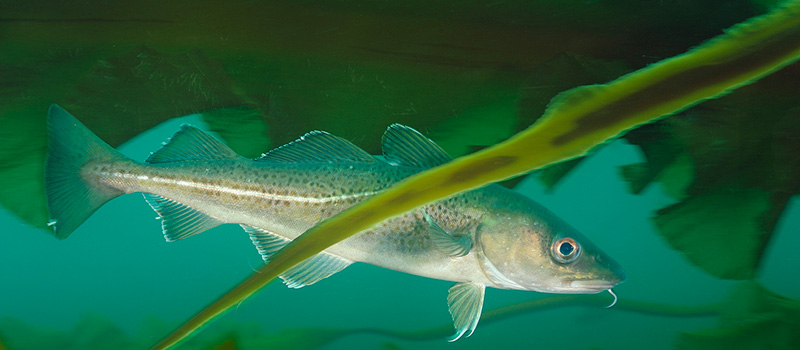This story was published in 2020 and updated in 2025.
For centuries, Atlantic cod has been essential to New England’s identity. Yet today, you can rarely find locally caught cod in a grocery store or on a menu – because the populations have been brought to the brink of disaster.
Because populations hover at historic lows, New England fishermen struggle to catch enough cod to make a profit. In fact, they mostly have to actively avoid catching cod to keep from going over catch limits. How did the numbers of this iconic species – once so plentiful that it became the backbone of local identity and industry – plummet to such levels?
“Overfishing got us here,” says CLF Senior Scientist Dr. Gareth Lawson, “and climate change is going to make it harder for us to get out.”
As a marine scientist, Lawson has spent upwards of 100 days a year on small vessels, waded through cod nurseries, and tagged hundreds of the fish. He enjoys fishing and prefers to eat cod salted since an old skipper in Newfoundland taught him the art.
Though scientists are encouraged to maintain neutral positions, Lawson has witnessed Atlantic cod’s downward trajectory firsthand and knows the stakes are high. A new scientific consensus has confirmed that there are five distinct cod populations in New England, and they’re all in trouble. For the species to endure, we need to allow them to rebuild.
Lawson moved from academia into advocacy when he became tired of just describing the problem. “It’s time to talk about solutions,” he says. “Ultimately, the fish need refuge. These are last-gasp populations we have to protect. This is about standing up for science and saving fish for future generations.”
Others at CLF feel this urgency as well. “The window for rebuilding the cod populations in New England is closing rapidly,” says CLF’s Senior Counsel, Erica Fuller. “The species is in real trouble, and it’s essential to ensure all fish populations are as resilient as possible before climate change alters the marine environment even further.”

Why haven’t people been more motivated to protect cod in the way we often protect birds or land animals?
“Here’s the thing about cod,” Lawson says, “or fish in general. People don’t see what they do. Even if you’re a fisherman, you bring a fish up on deck, and it’s dead. The fish don’t talk or express displeasure. So, we don’t think about their lives.”
Lawson, however, has learned to see more deeply – literally. “What grabbed me about cod is that, through technologies like submarine exploration and sonar, I could finally see what’s happening beneath the surface,” he says. “I’m motivated by an appreciation of their complexity.”
Lawson wishes that people could witness the elaborate cod mating display the same way they might watch a sage grouse ritual on the prairie. “With sonar, you can see their spawning columns, which used to be common in Newfoundland before overfishing,” he says. Cod are known to vocalize, making a grunting sound by using muscles and contracting the swim bladder during spawning. There’s also evidence that a more complex mosaic of spawning grounds once existed in New England.
“Cod tend to have fixed patterns, often returning to the same spawning and feeding grounds,” Lawson says. Some scientists believe that there aren’t many older fish left to lead younger fish to their historic spawning grounds. What’s more, many of those grounds have already been wiped out. The big, older female cod – which contribute exponentially more to successful spawning – have also largely disappeared, having been overfished for decades.
Recommendations about how cod stocks are managed, such as whether to close an area during the spawning season or set stricter catch limits, rest with the New England Fishery Management Council. Federal regulators at NOAA Fisheries then approve and implement its recommendations.
In part because they were working with an inaccurate understanding of cod populations, well-intentioned fishery managers have historically set limits on fishing that have resulted in overfishing of cod. As a result, Atlantic cod are depleted and lack enough healthy adult fish to replenish populations to a healthy level.
The federal Magnuson-Stevens Act (MSA) was enacted in 1976 to prevent overfishing. It requires fishery managers in New England and seven other regions across the country to set catch limits based on the best available science and end overfishing to help stocks rebound. But New England managers – and the federal agency that approves their decisions – have not always achieved this. Fishery managers have struggled to set sustainable limits that prevent overfishing and allow fishermen to thrive.
“In the face of uncertainty, you proceed with caution,” Lawson says. “You back off the maximum catch quotas. Otherwise, you find yourselves where we are now after years of chronic overfishing and a pattern of risky management choices.”
And where we are now, according to Libby Etrie, director of ocean policy at CLF, is in a cod fishery crisis. “The government has faced challenges in supporting the fish and fishermen,” Etie says. “It has struggled to make difficult decisions that prioritize rebuilding fish populations against impacts to fishing businesses. Taking significant action now is crucial for the fish and fishermen.”
Unsurprisingly, climate change is worsening everything for the species. The Gulf of Maine is warming faster than 97% of the world’s ocean, and the fish are feeling the heat. Like most species, cod have an ideal temperature range. If they’re too hot or too cold, it can negatively affect the fish’s metabolism, growth rate, disease resistance, and more. It can also impact the young cod’s food sources (plankton), distribution of predators, and the distribution of cod itself as the species shifts into deeper and more northern waters in search of cooler, preferred temperatures. Climate change poses a dire threat to cod, and allowing overfishing will only add to their woes.
What would cod population recovery efforts look like in practice? Here are the steps that must be taken to make a recovery of New England cod possible:
- End overfishing and place reasonable limits on fishing that will allow all New England’s cod populations to bounce back to healthy levels.
- Protect important cod habitat, especially places where cod spawn and older, larger cod gather. This includes protecting, strengthening, and creating new marine protected areas. CLF has nominated the Cashes Ledge area to become a national marine sanctuary, which would safeguard key habitat for cod.
- Develop science and management plans for the fishery that factor in climate change and the uncertainty arising from a rapidly changing ocean.
- Protect and restore species such as Atlantic herring that are key prey, or “forage,” species in the ocean food chain.
- Maintain high levels of monitoring of fishing to ensure accountability.

Sadly, New England’s precarious cod population is not unique; Atlantic cod stocks have also crashed elsewhere in the world, resulting in similar difficult decisions. Newfoundland enacted a moratorium in 1992, ending 500 years of commercial fishing; its cod population is only slowly rebounding.
That crisis is where the Canadian-born Lawson got his start in cod. “I was in grad school four years after the Newfoundland cod crash. I was interested in fish and marine science, so cod was very topical,” he says. “That’s what got me into cod – but what got me hooked on cod was spending time on small boats and working with fishermen. It was the connection to the maritime communities, people, and culture of Newfoundland.”
Through those early experiences, Lawson understands how protecting a species can sometimes change the nature of a town. “They were so resilient,” he recalls, thinking of the locals in the Newfoundland fishing villages impacted by the cod crash.
In New England, the crisis is already being felt by the small and midsize fishermen who could once count on cod for a comfortable livelihood for their families. Many of them are being driven out of business, powerless to compete in a management structure that benefits fishing businesses with greater capital. While critical to the survival of the iconic species, stronger limits on cod fishing will further affect these struggling communities. But failing to protect cod may hurt them even more.
CLF realizes the complexity of this position, and no advocate relishes the economic hardship that will follow the necessary steps. “Despite CLF’s long history of advocating for sustainable fisheries at the Councils, we haven’t ended overfishing,” Fuller says. “We want a better future for cod and for the communities that depend on it.”
“These are thorny problems,” Lawson acknowledges. “But we have to stand up for the species and the science.”
Today, none of the fishermen who plied New England’s waters prior to the 1980s would recognize the Atlantic cod population. Gone are the man-sized cod that were the stuff of local legend. Gone are the big old female fish able to replenish stocks. Without action now, gone, too, will be locally caught fish fries in the heat of summer and the cultural hallmarks of what was once a more balanced relationship between communities and fish.
